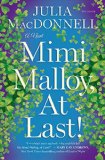Book Club Discussion Questions
In a book club? Subscribe to our Book Club Newsletter and get our best book club books of 2025!
For supplemental discussion material see our Beyond the Book article, Coming of Autumn and our BookBrowse Review of Mimi Malloy, At Last!.
Please be aware that this discussion guide will contain spoilers!
Note to book-clubs: of course we know you like to drink and snack while discussing a book. Please note that Mimi Malloy likes highballs, boxed chardonnay, Bloody Marys, coffee, salted nuts, donuts (vanilla creme with powdered sugar). Feel free to enjoy any of these (with a Sinatra record, if you like) for extra atmosphere while you have your group!
1. Mimi inhabits many female roles: homemaker, mother, daughter, sister, grandmother, wife, and girlfriend. Which of these roles are most important to her? Which are positive, negative, or both?
2. As narrator, Mimi speaks to the reader in a vernacular, funny, sometimes salty tone about her past, her family, her life. Why do you think this narrative voice is effective?
3. Mimi has been told that she "let herself go." She says "instead, I was erased." What in her life (besides her once "great gams") has she let go or been erased from? How does this affect her point of view?
4. Many different familial relationships are on display in this novel. One very complex one is that between fathers and daughters. What is your take on Mimi's father? How do her relationships with her ex, Jack, and with Duffy reflect her relationship to her beloved Da?
5. When her daughters wouldn't call her Mammy or Mommy, Mimi concluded that, "One vowel isn't worth a fight." How has Mimi allowed her family (family of origin and or her ex-husband and daughters) to shape her identity and opinions? What habits or elements of her personality does she fight for with her family?
6. The sisterhood of the Sheehan girls is based on their shared difficult childhoods. Mimi describes them as 'one body,' – "Lots of arms and legs, but a single heart and soul. Every now and again, this heart would break…" How did this intimacy play out through their lives?
7. The novel offers a view of the interior lives of children. What's going on in the lives of the 'glorious Sheehan girls' that they see differently from the way the adults perceive the same events? At what point do perceptions change? How?
8. Why do you think Mimi has not told her daughters about Da's musical accomplishments?
9. In a passage on page 287, Mimi recalls many types of "falling" that have occurred in her family. Why is she so concerned about these various types of falling? How does she relate them so what she sees as her own fall?
10. Discuss the notion of Irish identity compared to the Irish-American idea of Irish identity. Which does Mimi find more true for herself?
11. For both Mimi and for Duffy, true and false memories have been important. Which is more difficult to overcome? Would you agree with Duffy when he says that, "Forgetting's not always such a bad thing"?
12. Mimi's blue pendant plays an important role in the story. What do you think it represents? Are there any objects that play a similar role in your life?
13. "Faeries" can be both magical and dark. How have they impacted the overarching story of Mimi's life? How important are they?
14. How is Mimi Malloy, At Last! a "Cinderella story"? How does Mimi's story turn the Cinderella story on its head?
Unless otherwise stated, this discussion guide is reprinted with the permission of Picador.
Any page references refer to a USA edition of the book, usually the trade paperback version, and may vary in other editions.
